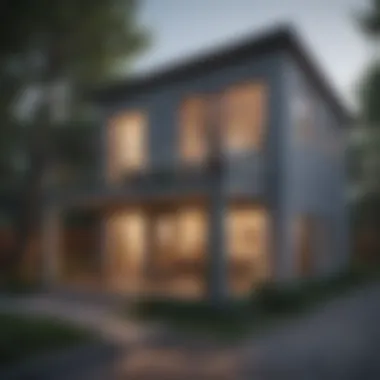Calculating Square Footage of a House: A Comprehensive Guide


Intro
Measuring the square footage of a house is a crucial step that goes beyond mere calculations. It plays a significant role in determining property value, space planning, and even design considerations. Homebuyers, real estate professionals, and even design enthusiasts must grasp how square footage affects various aspects of living spaces.
Understanding different measurement approaches, along with factors that influence results, is essential. For example, various architectural styles may require distinct methods of measurement. The implications this has on real estate valuation are also noteworthy. With that in mind, clear methodologies and practices will be outlined in detail.
Featured Homes
When discussing square footage, one cannot overlook the different architectural styles that can impact measurements. Whether it’s a cozy bungalow or an expansive modern mansion, each unique design element contributes to the overall square footage.
Architectural Styles
Consider the traditional colonial. This style often features symmetrical shapes and ample room. Calculating the square footage here is typically straightforward, as the rectangular shape allows for simple length and width measurements. In contrast, contemporary styles like the split-level or bi-level may complicate calculations due to their varied elevations and irregular layouts. Understanding the specific characteristics of these styles will enable more accurate measurements.
Unique Design Elements
Certain unique features can also add complexity when calculating square footage. For instance, vaulted ceilings and large windows can create dramatic spaces, but they do not contribute to the total square footage. When documenting square footage, such elements must be excluded from calculations to avoid inflation of the property’s value. It's crucial to distinguish between livable and non-livable spaces accurately.
Geographic Context
Square footage can also be influenced by geographic contexts. Local real estate markets may dictate what constitutes a desirable home size based on regional preferences. For example, urban homes in densely populated cities often prioritize compact living, while suburban homes may boast larger square footage.
Ending
In essence, calculating square footage is not just a numbers game. It involves understanding the inherent characteristics of different architectural styles and locations. By grasping these principles, stakeholders can make informed decisions regarding property valuation, enhancing their understanding of real estate dynamics.
"The value of a property is not just in its location, but also in the space it offers."
To delve deeper into this topic, further reading on architectural styles can be found at Britannica and measurement techniques at Wikipedia.
Understanding Square Footage
Understanding square footage is essential when discussing residential properties. This concept forms the backbone of how spaces are evaluated in terms of usability, value, and livability. The implications of square footage extend beyond simple measurements; they impact decisions that range from property valuation to design choices. It's fundamental for real estate professionals, potential homebuyers, and architects alike.
Definition of Square Footage
Square footage, simply put, refers to the total area of a floor space measured in square feet. This measurement encompasses all usable areas within the walls of a home. To accurately determine square footage, one generally measures the length and width of each room and then multiplies these numbers to get the area. The sum of all individual room areas gives the total square footage of the home. It's critical to note that this definition can vary slightly depending on local regulations, customs, and practices in measurement. Therefore, clarity on what is included in square footage calculations becomes vital.
Importance in Real Estate
The significance of square footage in real estate is multifaceted. First, it influences property valuation directly. Homes with larger square footage typically command higher prices in the market. Prospective buyers often consider square footage alongside other factors like location and condition when making purchasing decisions. Moreover, accurate square footage is crucial for appraisals. An error in measurement can lead to substantial discrepancies in market value, affecting both sellers and buyers.
Furthermore, understanding square footage helps homeowners optimize their living spaces. Space planning becomes easier when one knows the exact dimensions of their home. This knowledge can guide decisions on furniture, layout, and renovation possibilities.
"In the field of real estate, accurate square footage can make the difference between a good deal and a bad investment."
In addition, local zoning laws often dictate the allowable square footage for specific properties, particularly in urban settings. Potential homebuyers may ask about square footage when evaluating compliance with zoning regulations, ensuring they are making informed decisions about future property usage.
In summary, a clear understanding of square footage not only helps in making informed real estate investments but also plays a crucial role in how living spaces are perceived and utilized.
Methods of Measurement
The methods of measuring square footage are critical for ensuring accuracy in understanding the size of a house. Proper measurement not only defines space for potential homeowners but also plays a significant role in real estate transactions. Different techniques can yield varying levels of precision, which directly affects the valuation of a property. Understanding these methods can provide valuable insight for buyers, sellers, and real estate professionals alike.
Manual Measurement Techniques
Using a Tape Measure
Using a tape measure is one of the simplest and most common methods for calculating square footage in a house. This manual technique involves physically marking off the dimensions of each room, allowing for direct measurements of length and width. A significant characteristic of the tape measure is its accessibility; almost everyone can purchase one and use it effectively. It offers a tactile, hands-on experience that can enhance understanding of spatial dimensions.
One unique feature of using a tape measure is its ability to measure irregularly shaped areas. While it requires a person to manually walk through the space, the tape’s flexibility allows it to conform to corners and edges. However, there are disadvantages, such as the potential for human error in reading the measurements and the time it takes to measure each room individually. Despite these drawbacks, it remains a popular choice for many who prefer a straightforward approach to measurement.
Calculating Area for Each Room
Calculating the area for each room is a vital step in determining the total square footage of a house. This process involves multiplying the length and width of each room, giving a clear picture of how much usable space is present. A key characteristic of this calculation is its foundational importance in the overall measurement process. Each room's area is summed to derive the total square footage, making it essential for any accurate assessment.
The unique feature of calculating area per room lies in its ability to break down the measurements into manageable parts. This method allows for easier analysis when comparing different spaces within a home. However, it can lead to oversights if one forgets to include smaller spaces like closets or laundry rooms, which often contribute to the overall square footage. Nonetheless, this straightforward technique remains indispensable in home measurement.
Professional Tools and Technologies
Laser Measuring Devices
Laser measuring devices represent a significant advancement in square footage calculations. These tools utilize lasers to measure the distance between two points, providing quick and accurate results. A key advantage of laser measuring devices is their precision, which minimizes human error often associated with manual measurements. This makes them an excellent choice for professionals who require reliable data quickly.
Laser devices are particularly beneficial in large spaces or areas that are difficult to access. Unlike traditional tape measures, these tools can deliver measurements for high ceilings or hard-to-reach corners without physical effort. However, they do come with a higher cost compared to manual tools, which might be a barrier for some users. Ultimately, their efficiency and precision often justify the investment for serious buyers and real estate professionals.
Digital Measurement Applications
Digital measurement applications provide an innovative method for calculating square footage. These apps often integrate with smartphones or tablets, allowing users to input dimensions directly or even use augmented reality features to visualize spaces. A key characteristic of these applications is their convenience; users can easily take measurements on the go.
One unique feature of digital measurement applications is their capacity to store data and compute estimates automatically. Users can quickly access previously entered measurements, facilitating easier comparisons and analyses. However, reliance on technology can also pose challenges. Some applications might not work effectively in all conditions, especially if the camera's view is obstructed. Despite these considerations, digital applications are gaining popularity due to their ease of use and functionality, particularly among tech-savvy individuals.
Effective measurement techniques are essential for accurate real estate valuations and informed decision-making.
Types of Areas in a House
Understanding the different types of areas in a house is crucial for accurately calculating square footage. Each area serves its own function and can significantly impact the overall measurements. Distinguishing between living spaces and total square footage is essential for various purposes, such as real estate transactions, renovations, and even interior design. Therefore, examining these areas allows homeowners and potential buyers to make informed decisions based on the actual usable space in a home.
Living Areas vs. Total Square Footage
Living areas refer specifically to the spaces that are intended for daily use. These include rooms like the living room, bedrooms, and kitchens. In contrast, total square footage encompasses all areas within the boundaries of the property, including storage rooms, hallways, and even spaces that are not always livable, such as attics and basements. Understanding this distinction helps homeowners when they are evaluating their property's value and usability. It also directly affects how homes are priced in the market.


Inclusions and Exclusions
In real estate, knowing what is included in the square footage is key for both buyers and sellers. Certain areas may or may not be counted, which can impact perceived value.
Basements
Basements often vary widely in terms of their use and design. In many cases, they are not counted in the total square footage but can add substantial value, particularly if they are finished and used as habitable living space. A finished basement can significantly increase usable square footage and appeal for potential buyers. However, it is important to highlight that unfinished basements do not contribute to the liveable area and hence might mislead those unfamiliar with the details.
Attics
Attics offer another area where confusion may arise. Similar to basements, attics can be either finished or unfinished. If an attic is fully finished, it can be counted as living area and can add considerable value. Many homeowners see attics as a potential for extra bedrooms or playrooms, making them an attractive feature for families. However, storing items in an unfinished attic does not contribute to square footage the same way a properly finished space would.
Garages
Garages present unique considerations. Typically, they are not included in the liveable square footage of a home, yet they play an important role in overall practicality. A garage allows for vehicle storage and provides flexible space that can be converted or used for various storage needs. Home buyers often appreciate this feature, as it enhances the property's functionality. However, noting this exclusion in listings is crucial to avoid misrepresentation of actual living space.
Calculating Square Footage by Room
Understanding how to calculate square footage by room is a key part of grasping how living spaces are organized. Accurate calculations serve as a foundation for things like property valuation, space planning, and interior design. When potential buyers assess homes, knowing the square footage can give them a tangible sense of size and layout. For homeowners, clear measurements can guide remodeling or renovations.
Standard Room Sizes
In real estate, standard room sizes generally provide a baseline for calculating square footage. A living room, for example, typically measures between 200 to 400 square feet. Standard bedrooms usually range from 100 to 300 square feet. Kitchens can vary more, but their sizes generally range from 120 to 300 square feet. Knowing these sizes can simplify the process and provide quicker estimations when measuring.
To illustrate, consider these standard room measurements:
- Living Room: 250 square feet
- Standard Bedroom: 150 square feet
- Kitchen: 200 square feet
- Bathroom: 50 square feet
Calculating the square footage of these rooms helps in overall planning and can give a clearer picture of the entire home’s layout.
Non-Standard Shapes
Calculating square footage for non-standard shapes presents unique challenges. Not every room is a perfect rectangle or square. Many homes feature irregularly shaped rooms, such as those found in older buildings or custom designs. These types can require more advanced methods of measurement.
Triangular and Irregular Areas
When confronted with triangular or irregular areas, one must consider how these shapes contribute to the overall spatial understanding of a house. Triangular areas can often be found in attics or split-level homes, while other irregular shapes might arise in open-plan concepts.
The key characteristic of triangular or irregular areas is that they do not conform to one-size-fits-all measurement techniques. This poses challenges in estimation. Nevertheless, these spaces can provide distinctive aesthetics and functional attributes desired by many homeowners. The unique feature of these spaces is their potential for creativity in design. However, they may require more precise calculations to ensure effective use.
Use of Formulas
Using formulas for calculating square footage in non-standard shapes is essential. For triangular areas, the simple formula
allows for straightforward calculations. Knowing how to apply this formula helps when determining total square footage for unusual room shapes.
Formulas for these calculations are beneficial for providing accuracy. However, they do require understanding of geometric principles. The advantage of using formulas is the ability to gain precise measurements even for complex layouts. Despite their initial difficulty, they allow for an exact comprehension of a space's dimensions, thereby enhancing visibility of potential into layout designs.
Square Footage vs. Other Measurements
Understanding the distinctions and relationships among various measurements is vital in real estate and home design. Square footage is often a key metric when evaluating residential properties, yet homeowners and buyers should also familiarize themselves with other measurements like square meters. Understanding how square footage compares to these other units is crucial for making informed decisions.
Understanding Square Meters
Square meters serve as a valuable metric in many countries, particularly those using the metric system. Unlike square footage, which uses feet, square meters use meters for calculation. One square meter equals approximately 10.764 square feet. This conversion indicates that square meters can reflect larger spaces in a more manageable numerical format for those accustomed to the metric system.
When using square meters, comparisons can sometimes enhance clarity and facilitate international real estate discussions. This broader perspective allows homeowners to evaluate properties in different locales with ease. However, the challenge lies in accurately converting square footage to square meters, or vice versa. Understanding each unit’s role can guide buyers in selection processes and ensure they comprehend the available spaces thoroughly.
Converting Measurements
Converting square footage to square meters is a common task for anyone navigating international real estate or design. It can seem daunting, but the right approach simplifies the process.
Conversion Factors
Conversion factors are fundamental to accurate translations between square footage and square meters. The basic conversion factor is approximately 10.764. This number is essential when converting square feet to square meters and vice versa. The simplicity of this factor makes it a popular choice for many homeowners and real estate agents.
When using this factor, one can quickly multiply square footage by the conversion factor to derive square meters:
This method saves time and ensures precision, elements of utmost importance in real estate. However, accuracy could be compromised if there is a lack of familiarity with the units. This can lead to misinterpretations in property size, which can be significant in real estate transactions.
Practical Examples
Practical examples demonstrate how to utilize conversion effectively. For instance, imagine a home that boasts a square footage of 2,000 square feet. By applying the conversion factor:
In this scenario, a buyer can understand that the house is approximately 186 square meters. This information enables buyers to better visualize the space they may be exploring. Presenting square footage and square meters provides numerous options for communicating space, which can enhance negotiations or discussions among diverse stakeholders in real estate transactions.
Using practical examples makes complex concepts more digestible, and ultimately builds confidence among readers in their understanding of measurement systems in real estate.
Regulatory Considerations
Regulatory considerations in calculating square footage are vital to ensure compliance with local laws and standards. These regulations can affect not only the accuracy of the measurements but also how properties are valued and marketed in real estate. Understanding the legal framework surrounding square footage is essential for both buyers and sellers in the market. It sets a baseline for what is considered a livable area and can greatly influence property appraisals, thus impacting homebuyers' decisions and overall investment strategies.
Building Codes and Requirements
Building codes are established laws that govern construction practices. These codes specify how square footage is to be measured, including which areas are permissible to include and which are not. Adherence to building codes ensures that measurements are not arbitrary. As a result, it can prevent disputes between buyers and sellers, establishing clarity and trust in real estate transactions. Reliable square footage calculations help maintain safety standards and ensure that properties meet specific habitability criteria.
Local Variations


Local variations often dictate how different regions interpret square footage regulations. These specific nuances can be influenced by municipal governance, geographical factors, and community standards. Understanding local variations is important for accurate and credible square footage assessments.
State Requirements
State requirements also contribute to defining how square footage is calculated and reported. For example, some states dictate precisely what can be included in total square footage—like whether to count basements or garages. This regulatory framework often favors transparency within the industry. If a state requires disclosures regarding square footage, potential homebuyers are better equipped to assess a property's value.
The key characteristic of state requirements is their focus on standardization. This means that within a state, the same approach to measuring square footage is generally followed. Thus, it allows for a more consistent market experience. However, this does come with challenges. If a homeowner is buying a house from another state, they may find conflicting definitions regarding square footage.
Zoning Regulations
Zoning regulations play a significant role in how square footage impacts land use. These rules govern how parcels of land can be utilized, including restrictions on how much can be built and the types of structures allowed. Zoning laws can dictate whether a property can be used for residential or commercial purposes, which ultimately affects property value.
A unique feature of zoning regulations is their capacity to preserve the character of neighborhoods. For example, certain areas might restrict tall buildings to maintain a specific aesthetic. However, this can limit property owners who want to maximize their square footage for income-generating purposes like rental units.
Understanding these regulatory aspects is crucial for anyone involved in real estate—whether they are buyers, sellers, or real estate professionals. Ensuring adherence to local building codes and zoning regulations can lead to smoother transactions and better investment decisions.
Implications for Homebuyers
Understanding square footage calculations is crucial for homebuyers. This measurement often serves as a baseline for property evaluation, affecting decisions and expectations in the real estate market. The implications of square footage extend beyond mere calculations; they influence budgeting, investment potential, and alignment with individual needs.
Valuation and Pricing
When it comes to valuation, square footage plays a significant role. Real estate appraisers and agents typically use square footage to set a baseline price per square foot within a neighborhood. This can create a competitive edge for properties with larger square footage in similar locales. Buyers can utilize this information in negotiations, ensuring they do not overpay for a home that may not offer proportional space relative to its asking price.
The relationship between square footage and pricing can also reflect market trends. For instance, during a seller's market, homes with higher square footage often command premium prices. Conversely, in a buyer's market, the competition could decrease, allowing buyers to find better pricing on larger homes. Thus, understanding how square footage relates to pricing will empower buyers to make informed decisions.
Investment Considerations
Investment in real estate is often dependent upon factors like rental potential, resale value, and maintenance costs. The square footage of a home directly affects all these considerations. Larger homes can generate higher rental income, but they also entail higher upkeep expenses. Potential investors should weigh these factors against their investment goals.
Furthermore, the square footage implications translate into future value trends. Homes that are more spacious tend to appreciate in value at a different rate than smaller homes. It's essential to analyze market data before committing to a property investment.
"Understanding square footage can transform a buyer's approach to real estate, moving beyond a simple aesthetic appeal to a savvy financial strategy."
By factoring in both valuation and investment considerations, homebuyers can navigate the real estate market more effectively. This not only aids in immediate purchasing decisions but also serves long-term financial planning.
Architectural Styles and Square Footage
The relationship between architectural styles and square footage is significant in understanding a home’s design and valuation. Each style carries unique characteristics, which influence the space's functionality and appearance. These factors can greatly affect how square footage is perceived and utilized, impacting everything from family life to aesthetic appeal. In this section, we will explore two main comparisons: Modern vs. Traditional Homes and Small Homes vs. Large Estates.
Modern vs. Traditional Homes
Modern homes are often characterized by clean lines, open spaces, and a minimalist design. They tend to utilize square footage efficiently, favoring multipurpose spaces that can serve various functions. The emphasis is on light, space, and the integration of technology. This can lead to a smaller footprint while maximizing the perceived space.
In contrast, traditional homes typically feature more defined rooms and architectural details, taking a different approach to square footage. These homes are often larger to accommodate separate dining areas, living rooms, and sometimes even formal spaces like studies. While they provide character and warmth, traditional styles might require more extensive maintenance due to their intricacies. Because of their design, they can create the feeling of more space despite potentially having similar square footage to modern homes.
The choice between modern and traditional styles often reflects personal preference but should also consider the optimal use of square footage.
Small Homes vs. Large Estates
Small homes, often referred to as tiny homes, emphasize efficiency and practicality. The square footage in these homes tends to encourage smart storage solutions and multipurpose areas. Homeowners of smaller properties must be more creative with their space to ensure functionality without sacrificing comfort.
In contrast, large estates offer extensive square footage, allowing for more luxurious features such as expansive kitchens, multiple bathrooms, guest rooms, and extensive outdoor areas. While these homes provide ample space, they also present unique challenges, including higher maintenance costs and the potential for underutilization of space.
"When considering square footage, it's essential to understand how architectural styles impact living experience and property value."
Each architectural style has its advantages and disadvantages regarding square footage. Homebuyers should assess their lifestyle needs against these architectural considerations. Balancing personal aesthetic preferences with practical square footage considerations can aid in making informed real estate decisions.
Challenges in Accurate Measurement
Accurate measurement of square footage is critical in real estate, as it influences valuation, buyer decisions, and property assessments. However, there are numerous challenges that can result in inaccuracies. Understanding these challenges helps homeowners, real estate professionals, and buyers avoid costly mistakes. It also allows for a more informed approach when making decisions regarding property.
Common Mistakes
Mistakes in measuring square footage often originate from a lack of familiarity with proper techniques and tools. Common errors include:
- Ignoring architectural features: Not accounting for alcoves, recesses, and overhangs can lead to underestimating the true usable square footage.
- Incorrect calculations: Miscalculating measurements by not converting units accurately from feet to inches, for example, can lead to significant discrepancies.
- Exclusions of important areas: Often, areas like closets or balconies are overlooked, resulting in a less favorable square footage reporting.
- Misunderstanding room shapes: Many people fail to accurately measure non-standard room shapes. Triangles and circles require specific formulas that might not be familiar to an average homeowner.
By being aware of these mistakes, individuals can take steps to mitigate their impact. Using accurate measuring devices like laser distance measurers can significantly reduce human errors.
Complex Floor Plans
Floor plans that involve multiple levels or irregular layouts pose additional challenges in square footage calculation. Key considerations include:
- Multiple levels: Homes with multiple stories may require measuring each floor separately. It is important to sum these measurements to get the full picture.
- Irregular shapes: For rooms that do not follow standard rectangular or square shapes, the use of geometric formulas is essential to determine area. Using triangular calculations and dissecting complex shapes into manageable parts can simplify the process.
- Open floor plans: With trends towards open spaces, accurately determining square footage becomes difficult. One must consider how shared spaces like combined living and dining areas should be analyzed.
Accurate square footage determination in these situations requires patience as well as methodical planning. Taking rough sketches can assist in visualizing direct measurements and ensuring all sections are captured. Moreover, working with professionals, when possible, can help avoid oversights.
Tip: Always document measurements clearly, noting any complex features that need special attention. This will make it easier to return and validate your measurements later.
Embracing these ideas can help establish a clearer and more informed understanding of square footage, leading to better decisions in the realm of real estate.
Square Footage in Real Estate Listings
In the realm of real estate, square footage plays a critical role. It serves as a foundational metric for valuing properties. When buyers search for homes, one of the first details they examine is the square footage. Understanding this can greatly influence their decision-making process. Similarly, sellers need to present this information effectively to attract potential buyers.
Standard Practices for Listings
Real estate listings typically follow several standard practices regarding square footage. First, it is common to display the total square footage prominently. This should include both livable and non-livable spaces, provided they are relevant to the property.
- Clear Listing: Properties should showcase their square footage in a straightforward manner, either in the listing title or description.
- Room Breakdown: Some listings include a breakdown of square footage by room, assisting buyers in visualizing the space distribution. For example, indicating that the living room is 300 square feet while the kitchen is 200 can provide better context.
- Use of Terminology: It's crucial to use clear terms when describing areas. Terms like "finished basement" or "unheated attic" should be clarified, as they influence buyer perceptions about usable space.


Further, adhering to local guidelines and practices can enhance credibility. State agencies may have specific mandates on how to calculate and present square footage. Thus, knowing local regulations is beneficial.
Importance of Accurate Data
Accurate square footage data facilitates trust between buyers and sellers. Misrepresentation of square footage can lead to disputes and erode buyer confidence, which can have serious implications for sales processes.
- Value Assessment: Square footage directly impacts property valuation. If a home is listed with incorrect data, it may either undervalue or overvalue the property, causing financial losses.
- Legal Compliance: Various states require accurate square footage in the disclosures and listings. Failure to comply with these regulations can result in legal consequences for sellers.
- Market Transparency: Accurate data fosters transparency in the market. When buyers can rely on square footage figures, they feel more empowered during negotiations.
Accurate representation of square footage is essential. Misleading figures can result in significant buyer dissatisfaction and legal challenges.
Tools for Calculating Square Footage
Calculating square footage accurately is essential for various reasons, including real estate transactions, renovation planning, and interior design. Proper tools can streamline the measurement process, benefiting both casual homeowners and professionals in architecture and real estate. From online calculators to mobile applications, these tools facilitate precise and rapid calculations, ensuring that users understand the dimensions and area of their properties.
Using the right tools offers substantial advantages. These benefits include:
- Speed: Automated tools can execute calculations much faster than manual methods.
- Accuracy: Digital calculators often provide higher accuracy, reducing human error.
- Ease of Use: Many online resources and applications are user-friendly, making it accessible for anyone.
"Accurate measurement is the foundation for every construction and renovation project."
In the following subsections, we will explore two significant categories of tools available for square footage calculations: online calculators and mobile applications.
Online Calculators
Online calculators are widely popular for their convenience. These tools can be accessed from any device with internet connectivity. Users input dimensions for each room or area, and the calculator provides immediate square footage calculations. Some of the advantages of online calculators include:
- Variety of Options: Many websites offer different types of calculators, accommodating diverse measurement needs (e.g., irregular shapes).
- Detailed Outputs: Beyond simple area calculations, some calculators provide additional insights, such as estimated costs for flooring based on square footage.
- Cost-Free: Most online calculators are free to use, making them an economical solution for homeowners.
However, users should consider their own skill level in handling these tools. More complex calculators require a better understanding of geometry and design principles.
Mobile Applications
Mobile applications offer a sophisticated alternative for calculating square footage on-the-go. These apps are particularly advantageous for individuals who frequently engage in property evaluation or renovation projects. Some key features are:
- Portability: Users can measure and calculate right at the site, eliminating the need for returning home to do calculations later.
- Integration: Many apps allow users to save or share measurements directly with contractors or designers, speeding up communication.
- Advanced Tools: Some applications feature augmented reality capabilities (AR) that can provide real-time visualization of spaces while measuring.
In summary, both online calculators and mobile applications are essential tools for anyone needing to calculate square footage. While the choice between the two may depend on personal preferences and situations, both can provide a higher level of efficiency and accuracy in measuring spaces.
Real-Life Examples
Understanding the square footage of a house extends beyond mere calculations. Real-life examples illuminate how square footage influences buyer preferences, market trends, and property values. By examining case studies of different homes, one can discern practical applications of square footage measurements and their implications in real estate. These examples ground theory in reality, providing context and clarity.
Case Studies of Different Homes
Analyzing various homes reveals distinct characteristics shaped by their square footage. Consider two houses located in the same neighborhood, one measuring 1,200 square feet and the other 2,500 square feet. The larger home likely offers more living space, additional rooms, and enhanced amenities. This size difference can significantly impact the perceived value and selling price.
Example 1: Urban Apartment
An urban apartment measuring 800 square feet focuses on maximizing space through open layouts and multifunctional furniture. Buyers are often attracted to the concept of efficient living, and the square footage reflects manageable maintenance.
Example 2: Suburban Family Home
A suburban family home of 2,800 square feet commonly features separate rooms designed for specific functions. Here, the square footage accommodates family needs and social gatherings. Such homes may include a finished basement and a spacious yard, enhancing value further.
Analyzing Square Footage in Valuation
Square footage plays a crucial role in property valuation criteria. Assessors and real estate agents frequently rely on square footage to gauge a home's market value. Larger square footage often correlates with higher price points, assuming quality locations and features are equivalent.
When analyzing properties, one common method applies the price per square foot calculation. This involves taking the sale price and dividing it by the total square footage, providing a standard measure that facilitates comparisons between homes.
For instance, a home priced at $300,000 with 2,000 square feet is valued at $150 per square foot. Buyers often use this measure to evaluate potential investments against market averages, shaping decision-making processes.
In summary, real-life examples and case studies enable stakeholders to understand the complexities surrounding square footage calculations. The impact on market valuations, along with buyer preferences shaped by specific characteristics, provides valuable insights into the world of real estate.
Future Trends in Home Measurement
The landscape of home measurement is evolving significantly. Understanding these future trends is crucial for anyone involved in real estate, architecture, or home purchasing. The integration of advanced technologies and sustainable practices are redefining how we approach square footage calculations. These developments promise to provide benefits such as improved accuracy, better resource utilization, and enhanced user experience in home measurement.
Technological Advances
Technology is playing a vital role in the evolution of home measurement. Innovations such as 3D scanning and augmented reality are becoming more accessible to homeowners and professionals alike. 3D scanning allows for a detailed capture of a space’s dimensions and features, creating accurate digital models
- Enhanced Accuracy: Traditional methods of measuring can often lead to errors due to human miscalculations or even tool limitations. With scan data, users can obtain precise metrics that were previously harder to achieve.
- User-Friendly Applications: Applications like MagicPlan allow users to create floor plans merely with their smartphone cameras. This ease of use encourages more individuals to engage with measuring processes effectively.
In addition, the rise of artificial intelligence offers promising features such as predictive analytics for space utilization. AI can help homeowners visualize how different layouts can affect overall square footage calculations. These technological advancements offer opportunities not just for measurement accuracy, but for future planning as well.
Sustainable and Eco-Friendly Designs
The focus on sustainability is reshaping how home measurements are perceived and executed. Homebuyers are now prioritizing eco-friendly homes, and square footage plays a role in this shift. Factors to consider include:
- Efficient Use of Space: Sustainable designs often emphasize smaller footprints while maximizing utility. Efficient layouts can help reduce the carbon footprint by using fewer materials and resources.
- Smart Home Technology Integration: Homes equipped with smart devices can monitor energy consumption within given square footage. This information helps homeowners make informed decisions about their resource use, enhancing overall sustainability efforts.
By marrying square footage calculations with sustainable design principles, builders and architects can contribute to creating more environmentally conscious homes.
"As we look towards the future, understanding home measurement trends helps align our values with innovative solutions."
The incorporation of these elements not only influences personal living choices but also impacts real estate market dynamics. Overall, the integration of technological advances and sustainable practices in home measurement will play a significant role in shaping future living environments.
The End
When considering the square footage of a house, it is essential to recognize its importance in various realms, including home buying, property valuation, and even architectural design. Accurate measurements serve as a cornerstone for these processes, influencing decisions and investments significantly. In this article, we have covered in detail the various methods of calculating square footage, from manual techniques to professional tools, ensuring readers gain a comprehensive understanding of this pivotal concept.
Summary of Key Points
- Understanding Square Footage: A clear definition and its significance in real estate set the foundation for why accurate measurements matter.
- Methods of Measurement: Various techniques—from tape measuring to using laser devices—ensure precision when evaluating spaces.
- Types of Areas: Differentiating between living areas and total square footage and understanding what is included or excluded from measurements is crucial.
- Challenges: Acknowledging common pitfalls in measuring and the complexity of certain floor plans can save time and avoid errors.
- Future Trends: Keeping abreast of technological advances is vital for anyone involved in real estate or architecture.
Final Thoughts on Square Footage
Square footage is not merely a number; it is an integral factor that influences real estate markets and personal decisions. Homebuyers must approach their investments with this knowledge, recognizing how it correlates with value and usability of space. By maintaining accuracy in measurements, one can secure a more informed position within the property market.















